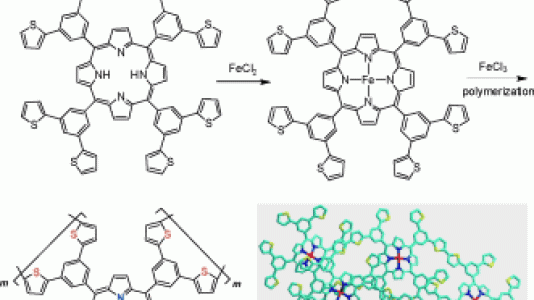
Oxygen reduction reaction (ORR) represents a critical step for proton exchange membrane fuel cell (PEMFC) operation. The cathode catalyst materials of choice are platinum group metals (PGMs). The high prices and limited reserves of PGMs created a major barrier for large scale PEMFC commercialization. Intensive efforts have been dedicated to search for low-cost, non-PGM alternatives. The current state-of-art catalysts are prepared by applying transition metal and N-containing molecular or polymeric complex over the carbon support, followed by thermal activation. One major drawback of such an approach is the use of catalytically non-active carbon, which dilutes the over catalytic site density and, therefore, limits the potential for the activity improvement.
In a paper [1] recently published in the journal of Angewandte Chemie International Edition (impact factor = 13.455), we reported a new method of fabricating a highly efficient, “support-free” oxygen reduction catalyst for fuel cell application using an ultrahigh surface area polyporphyrin as precursor. Polyporphyrin is a new form of porous organic polymer (POP) we initially developed for hydrogen storage application. It was prepared by the oxidative coupling of monomeric porphyrin to form a porous network containing a high density of nitrogen-coordinated iron macrocyclic centers. Upon pyrolysis, the POP was converted to a highly active electrocatalysts for ORR in an acidic electrolyte. Since the POP, itself, is porous and self-supporting, no additional carbon support is needed. Proton exchange membrane fuel cells prepared with such a catalyst at the cathode achieved very high measured volumetric and gravimetric current densities of 20.2 A·cm-3 and 39.4 A·g-1 at 0.8 V, respectively, and a peak power density of 730 mW·cm-2 at 0.4 V, which is among the best reported in the literature. This study opens up a new direction in searching for new non-precious metal electrocatalysts with enhanced activity and durability using a variety of existing organic monomers and crosslinking chemistries.
This work was supported by DOE, Office of EERE Fuel Cell Technologies Program and Office of Sciences.
“A Highly-Active and Support-free Oxygen Reduction Catalyst Prepared from Ultrahigh-Surface-Area Porous Polyporphyrin” S. Yuan, J.-L. Shui, L. Grabstanowicz, C. Chen, S. Commet, B. Reprogle, T. Xu, L. Yu and D.-J. Liu, Angewandte Chemie International Edition 2013 DOI: 10.1002/anie.201302924